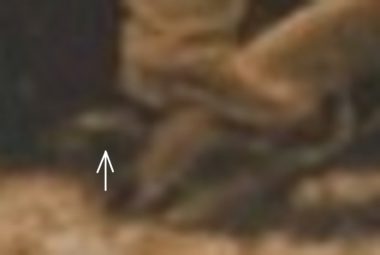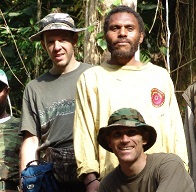By the living-pterosaur crytozoologist Jonathan Whitcomb
Police officer William Lashomb was on the Parker Avenue Bridge, one afternoon in Massena, New York, around the summer of 2004, having just finished talking with a driver who had stopped on the bridge, when he saw something. A featherless light-greenish-gray creature was flying downstream, at first 15-20 feet above the surface of the Grass River but soon diving down to just a few feet above it, passing the officer.
He later told his wife about it, having no doubt that it was a prehistoric creature. He did not report the encounter to me until after he had retired.
In 2006, I had a long phone conversation with the retired police officer and he sounded credible. William Lashomb, however, is only one of many eyewitnesses who have reported to me a sighting of an apparent modern pterosaur.
Be Aware: Jonathan Whitcomb no longer supports this Ptp image as any valuable piece of evidence, as of late 2018. If anything changes in provenance issues, he may update this.
UPDATE: The following is from the original post of May, 2017:
That’s a critical point in recent examinations of the Civil War photograph called “Ptp.” It’s not just a few American soldiers in the 19th century who have encountered an extant pterosaur, but people all over the world have observed them, including eyewitnesses in the 20th and 21st centuries. That is the context.
Folded wings (inverted wings): evidence of authenticity for this old photograph
Before 2017, it seems that no skeptic mentioned the inverted wings in this photo. If Ptp is from before 1870, how did those soldiers know enough about pterosaur anatomy to create a model that had folded wings? If the photo is as old as it looks, that animal really is a pterosaur, but how do we know it is that old?
The scientist Clifford Paiva, a physicist in California, discovered a tree branch or block of wood under the foot of one soldier. That is evidence the photograph was taken before about the year 1870, when people needed to be kept motionless for many seconds when a photograph was recorded. I was delighted when he told me that news, early in 2017.
Prop used to keep shoe and beak motionless when the photo was taken
Taken in context with the folded wings, the prop discovered by Paiva is evidence the animal was an actual modern pterosaur, not any model constructed by those men.
Pterosaur Sighting Reports in Context
For those unaware of the many sighting reports of modern pterosaurs, that old photo can look very strange, even inexplicable. Yet one of the major criticisms that skeptics have thrown out in ridicule of living-pterosaur investigators has been the lack of photographic evidence for the existence of any non-extinct pterosaur. Critics have refused to believe any of the reported eyewitness sightings of extant pterosaurs and the “no photo” criticism has been used as one of their chief weapons.
We now have a clear photograph that shows the form and features of a modern pterosaur, albeit it’s apparently from the 19th century. Yet with at least one of their species surviving into the 1800’s, why would they now be extinct in all their species?
###
copyright 2017 Jonathan Whitcomb
.
The two scientists who discovered a modern pterosaur
Paiva found evidence that this is indeed an old photograph: Notice the tree branch under the beak of the animal. It was used as a prop to keep the man’s shoe as steady as possible . . . This is in keeping with photographic technique before about 1870.
.
After about 1870, photographers did not have such a need for keeping persons motionless, for snap shots were becoming common because of improvements in the technology. But we have additional evidence of authenticity in the [photo]: . . .
.
Cliff Paiva and I do not proclaim that the animal seen in Ptp must have been a species of Pteranodon. We simply point out that similarities in the head suggest that it was a modern pterosaur at least similar to a Pteranodon.
.
According to standard models of Western science, pterosaurs lived long ago, in what is called the “late Triassic” to the end of the “Cretaceous Period,” that being thought to have been 65-220 million years ago. But according to some cryptozoologists, there is no evidence at all for the extinction of all species of pterosaurs. That idea that they are all extinct is just an assumption, not based on any solid evidence.
.







